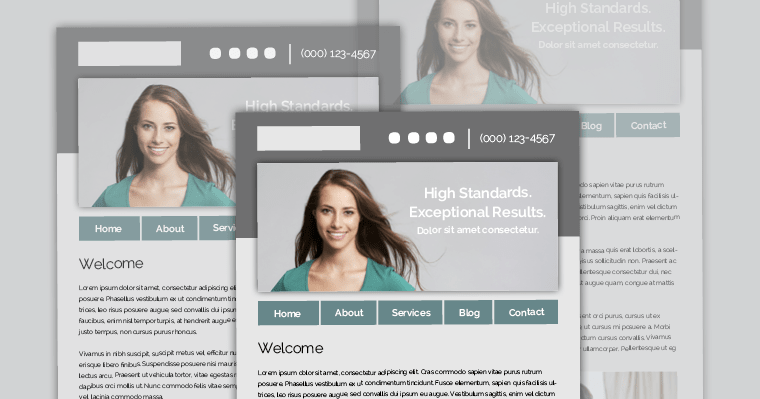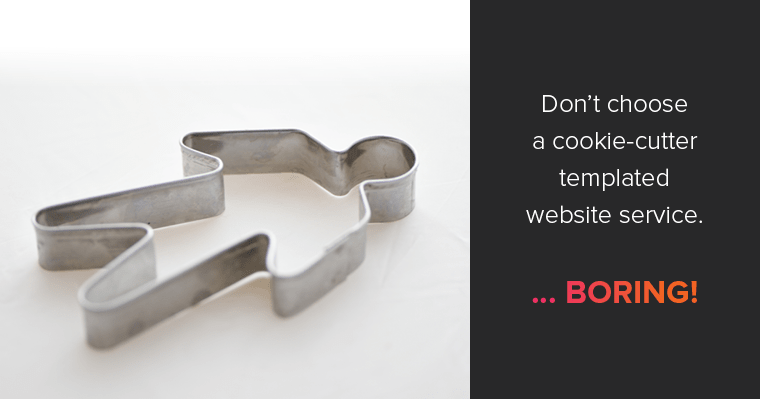Why Unique Dental Websites Are More Effective Than Template Websites

A few weeks ago, we received a request for a free website audit from a potential new client.
Angela opened the request, clicked the link for the practice’s website, recognized it immediately, and thought, “Huh. We just did a website audit for them last week. Wonder why they’re requesting it again?”
As she looked through her records, she realized… nope… this wasn’t the same practice.
This was another practice in another city.
However, comparing the site’s side by side… they were nearly exactly the same.
Seriously.
The logo was just about the only unique thing on the page. Same background. Same fonts. Same headlines. Same stock images.
Same, same, same.
If the two practices are in different cities, who cares? Why does it matter if they have the same template websites? They won’t attract the same patients, after all.
Obviously, we’re a dental website company so we’re going to tell you your dental website design should be unique and amazing (no surprise there). But besides the icky “sameness” of a boring template website, is there really a reason it wouldn’t be effective with patients in your community?
Good questions, right? So I set about to figure it out.
Does design (really) matter?
Interestingly, in researching this blog post, I stumbled across this article by Jason Putnam, in which he references a study about health websites specifically. Considering healthcare websites are our thing, it piqued my interest.
The goal of the study was to determine how much impact a website’s design has on the trust and mistrust of health websites. Participants searched for health information online and were asked about their first impressions of the sites they found. Here’s the thing:
Design-related factors contributed to 94% of the reasons users rejected or mistrusted a site.
Yeah. You read that right.
It wasn’t the doctor’s education or years of experience.
94% of the time, the way users felt about the trustworthiness of an organization was design-related.
Some of the specific problems cited included:
- Complex, busy layout
- Boring design, especially in the use of color
- Too much text
- Corporate look and feel
…all of which are common issues with template websites.
Whether you’re a dentist or a healthcare provider or a small business, the principles apply universally – first impressions are everything. Consumers are adept at sniffing out cookie-cutter template websites and stock images.
And then, there’s the issue of… (imagine a pause here for dramatic effect)… dreaded DUPLICATE CONTENT.
Making the case for unique content
Okay, okay, it’s not as dramatic as all that.
Duplicate content isn’t going to bring about the apocalypse.
But it’s a real issue to consider from an SEO perspective as well as from a user’s point of view. Google defines “duplicate content” as this: “Duplicate content generally refers to substantive blocks of content within or across domains that either completely matches other content or are appreciably similar.”
Google has specifically stated that it does not technically penalize duplicate content. However, if your site contains a fair amount of duplicate content, you could suffer losses in rankings and traffic. Why?
Search engines want to provide the most relevant results for users. So if multiple versions of the same content appear in several different places, the search engine must choose which version is likely the original and/or best option to display in search results.
This dilutes visibility for all the places this content appears.
Time and again, we’ve seen dentists come to us with template websites containing a fair percentage (30-40%) of duplicate content. It’s reasonable to conclude this will affect their rankings, visibility, and conversions.
Let’s also consider how it affects potential new patients.
Canned, templated content doesn’t take into consideration the barriers YOUR target market faces – nor does it prove out the unique ways YOU overcome them, nor does it show how your practice serves and supports YOUR community.
You and your team work every day to help patients overcome hurdles to accepting dental care, whether it’s helping them navigate their dental insurance or getting them in for an evening appointment or reassuring them that sedation is just the thing that will help them with their lifelong fear of the dentist.
These are areas where stock content and headlines commonly found on template websites just won’t cut it.

Cookie cutters are for baking cookies, not for designing websites
Let’s be real here – we’re not anti-TEMPLATE, per se. Templates can be time-savers when it comes to the actual development of a website.
However, if a template LOOKS like a template, well, then, there’s the issue.
So how can you ensure your dental website doesn’t look like every other dentist’s site out there?
1. Identify your why.
Your UVP – Unique Value Proposition – is your WHY. Why do you do what you do? Why do you want to help patients? Why are you unique?
Why should patients choose you over Dr. McDentist down the street?
Once you’ve identified your UVP, it becomes the cornerstone of your marketing and website content. This awesome blog post by Mel, one of Roadside’s website-creating extraordinaire’s, explains why and how to identify your UVP (and contains a super-simple free tool to help you do it!).
2. Just say “no” to stock photography.
When patients are shopping for a new dentist, they want to see you, your practice, your team, and the atmosphere you’ve created.
It may be necessary and appropriate to use stock photos here and there, but the majority of visuals on your site should be your own!
Marketing Experiments tested this out. On a homepage, they tested a stock photo of a smiling woman against a smiling photo of the founder of the company. The result? When the recognizable photo of the founder was used, visitors were 35% MORE likely to sign up for a free consultation. 35%!
I love this take-away from their experiment: “Your customers are pretty savvy. They know Smiley McHeadset doesn’t really work for your company. Do you think that deepens the trust with your company?”
It goes without saying that patients want to trust their dentist. Does your website’s photography inspire trust?
REAL photos and videos create the RIGHT first impression, humanizing the practice and helping patients overcome fears.
To see killer examples of practices that are doing it right, check out these dental websites:
- Serene Oaks Dental
- Karmazin Dental
- Arch Dental Fargo
- Aesthetic Dental Center
- Broderick, Dusek, & DeLeon Orthodontics
- De Pere Smiles
3. Be a savvy shopper.
When choosing a website company, take the time to review their portfolio carefully.
Does each website start to look the same? Are the headlines repetitive? Do they have case studies where you can review the strategy and motivation behind the website’s marketing message?
Ask questions.
Does the company write unique content for each website? Do they have a system to help you discover your UVP? Should you choose to part ways, do you own the website and its content?
Conclusion
Here at Roadside Dental Marketing, we’re all about creating websites that show off your practice’s uniqueness. We know you have other stuff on your plate (like, ahem, running a business) so we’ve developed a proprietary system to make the process ridiculously easy for you!
Interested in learning more about what we do?



